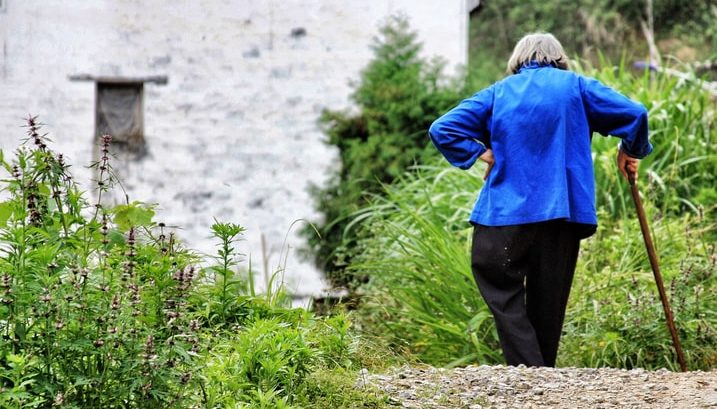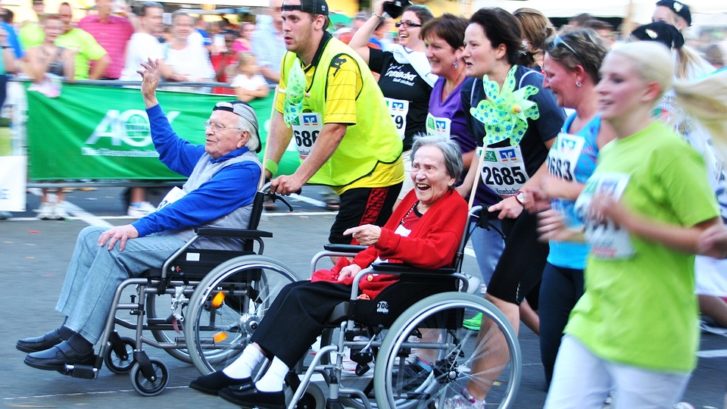


Planning for incapacity: Dementia in Focus
As improvements in medical science and technology allow us to live longer, incapacity – both physical and mental – is becoming a growing local and global problem. Contrary to popular misconception, dementia is not a normal part of ageing, but rather a degenerative brain disease – with age being the single biggest risk factor for developing the illness. Simply put, the longer you live the more likely you are to get the disease. Unfortunately, legislation and policy have not kept pace with the growing need for the affairs of those with diminished mental capacity to be looked after.
Although the World Health Organisation recognises dementia as a public health priority that is on the increase with no foreseeable cure, South Africa has massive strides to take in providing adequately for the health, legal and financial needs of those who suffer from the disease. Whereas countries such as Canada, Australia and France have dementia policies in place, no such policy exists in this country. In fact, dementia is not listed as a prescribed minimum benefit and the Department of Health does not recognise it as a chronic disease. Most open medical schemes do not recognise the illness as a chronic condition and very little cover is provided for the illness, if any.
From a global perspective, it is believed that around 50 million people have dementia and that there are 10 million new cases diagnosed each year. According to South Africa’s 2011 census, there were 2.2 million people living with dementia at that stage, and this number would have increased with global trends. While the majority of dementia cases are caused by Alzheimer’s disease, other causes can include vascular disease, brain injury, cancer and HIV. Recent reports by Alzheimer’s Research UK reveal that 2 out of every 100 people between the ages 65 and 69 have dementia, whereas this number rises to 1 out of 5 people between the age of 85 and 89 – to the extent that 7.1% of people over the age of 65 have dementia.
Eric Jordaan – Crue Invest (Pty) Ltd, writes about this topic for Moneyweb: Planning for incapacity: dementia in focus. To read the rest of the article, click here.
To download Shire’s Company Overview brochure, please click here.

Frail Care: What you should know
This article was first published in the first-quarter 2015 edition of Personal Finance magazine.
Laura du Preez writes:
“Healthcare issues loom large in later years when illnesses linger and can result in loss of control over daily living. At these times, residents of retirement villages or homes and their children often take comfort in the fact that the village or home has healthcare or frail-care facilities.
But you may be in for some unpleasant surprises if you are not acquainted with exactly what is on offer in a particular village or home, what additional costs you will incur and what you can claim from your medical scheme. The specifics of an illness and the requirements of your care may also determine whether or not you can be assisted in your community or need to go beyond it.
It is important to know that there is a difference between medical care and frail care, and while your medical scheme will pay for your medical care, it will usually not pay for the care you need when you are unable to manage the normal activities of daily living without assistance.
There are some exceptions, mostly among the restricted medical schemes. Open schemes, which must accept anyone who applies to join at any stage of their lives, cannot afford to contribute to the costs of the long-term care you need when you are frail.
What exactly is frail care?
Frail care is the care you need when you are unable to perform activities of daily living, such as eating, personal hygiene and moving about without assistance.
When you are no longer able to look after yourself because of frailty or mental incapability, you are unlikely to return to independent living.
Frail care is the care you need when you are no longer able to look after yourself because of physical frailty or mental incapacity.
Peter Jordan, the principal officer of Fedhealth, a large open medical scheme, says that while medical care falls within the ambit of medical scheme cover, frail care, or any kind of assisted living, is considered a social welfare responsibility.
Alain Peddle, the head of research and development at Discovery Health, says there may be times when you are recuperating from a health event, such as a stroke or an accident, and when you need short-term assistance with daily living before returning to your former independent state. Such short-term help could be covered by your scheme, but cover for the cost of your longer-term accommodation in a frail-care facility is rare.
Bankmed, a restricted scheme, contributes to the costs of frail care on some options. Dr Niri Naidoo, the clinical and operations executive at Bankmed, says that members of the scheme’s top three options, Traditional, Comprehensive and Plus, are entitled to a benefit of 50 percent of the cost of frail care to a maximum of R355 per beneficiary per day. You have to motivate for the benefit, and the claim is assessed by a medical adviser, Naidoo says.
Contributions on the least costly of the three options, the Traditional option, start at R1 917 for a single member earning less than R5 000 a month, to R2 326 for a member earning more than R10 000 a month. These options also pay 100 percent of the cost of home nursing, to a maximum of R270 per beneficiary per day.
Another restricted scheme, Anglo Medical Scheme, has a benefit of R54 355 per beneficiary per year on its top option, which costs R3 170 a month including contributions towards a medical savings account. But the benefit is only for “medically related frail-care services”, which means you will receive it only if you are recovering from an illness, injury or surgery.
Principal officer Fiona Robertson says the aim of the benefit is to keep high-risk members out of hospital, because one expensive hospital event may cost the equivalent of several years of frail care. Once members require constant nursing or assistance, usually when their condition is medically irreversible, they may be classified as at high risk of fractures or repetitive infections, or may be mentally incapable of taking the correct medication, she says.
The scheme will not pay for frail care when the needs are not medical, but the line between social and medical needs is not always clear, Robertson says. Alzheimer’s disease and dementia, for example, are common reasons for granting frail-care benefits.
Jordan says that while your scheme may not cover accommodation and care in a frail-care centre, any chronic medication you require when you are frail, visits to or by a general practitioner (GP) or specialist, as well as the cost of various appliances you might need while in the frail-care facility, may still be paid by the scheme in line with your benefits.
Levels of care
A frail-care facility should be staffed by carers under the supervision of a nursing sister. Carers may be trained to take care of older people, but are normally not medically trained.
Frail-care facilities need to be registered with the Department of Social Development under the Older Persons Act. The Act sets standards for these facilities and requires annual inspections.
The department is also working on introducing training for carers in these facilities.
While “frail care” sounds straightforward, confusion arises when a retirement village offers both frail care and what is known as a sub-acute care facility. To understand what a sub-acute care facility is, it is useful to know what is regarded as an acute care facility.
The Board of Healthcare Funders (BHF), which represents medical schemes and their administrators, issues the practice code numbers that are used by schemes to identify registered healthcare providers. The BHF explains the difference between an acute care facility and a sub-acute care facility as follows:
* Care in an acute care facility: this is typically care in a facility registered and licensed as a hospital by the provincial department of health in terms of the Health Care Act. An acute care hospital has operating theatres and intensive and/or high care units.
A day clinic, which has an operating theatre but is not equipped for overnight stays, is also regarded as an acute care facility, the BHF says.
A third type of acute care facility is a mental health hospital that treats patients with acute mental health problems, according to the BHF.
These hospitals should have practice code numbers, which you need to claim for admission, in line with your medical scheme benefits.
* Care in a sub-acute care facility: these hospitals treat you when your condition is less serious, or after your release from an acute care hospital, the BHF says.
A sub-acute care facility is equipped like a hospital, has appropriately qualified and registered nursing personnel and must be licensed by the provincial department of health under the Health Care Act. However, Peddle says a sub-acute care facility lacks operating theatres, high-care or intensive care units, and pathology and radiology services.
In a sub-acute care facility, you will receive high-quality nursing care, but should have no need for the high-tech care you would receive in high care, intensive care or in a theatre unit, the BHF says. Your condition must, therefore, be stable.
Some sub-acute care facilities will treat you only after surgery or if you have a non-psychiatric medical condition, depending on the discipline code allocated to the facility, the BHF says.
Some facilities focus on psychiatric conditions and others offer physical rehabilitation. Some are post-natal units and some offer all sub-acute services.
Sometimes the term step-down facility is used to describe a sub-acute facility. However, the BHF says step-down care is less intensive than sub-acute care and is typically for short stays. It is a substitute for an extended hospital stay, and you may be referred to a facility offering step-down care if you still need significant medical involvement and skilled nursing care of more than three hours, on average, a day, as well as pharmacy and laboratory support.
Sub-acute care facilities also need a practice code number, and if you are admitted to such an establishment, you can claim for your stay there, in line with your benefits, from your medical scheme.
If a sub-acute facility is focused on rehabilitating you to normal or near-normal functioning after a disease or injury, you are likely to have access to practitioners across medical disciplines. The care they provide will be goal-orientated, and once their goals are reached, you are likely to be sent home. For example, you may be sent to a sub-acute care facility after a stroke. A neuro-physiotherapist could assist you to walk, a speech therapist could help with your speech and swallowing, and an occupational therapist could help with your movement, vision and concentration.
Peddle says therapies might be supplemented by consultations with a social worker, dietician, psychiatrist or medical doctor.
This treatment can occur in acute care settings, acute care rehabilitation units and sub-acute care units that are licensed to provide rehabilitation.
Asked if Discovery Health Medical Scheme would require a member to use a particular facility, Peddle says this would depend to a large extent on the range of healthcare services you need, compared with what the facility is able to offer. In all instances, he says, Discovery Health will fund services only from registered healthcare professionals and facilities that have practice code numbers issued by the BHF. This means that if a retirement village has a healthcare facility, it must be registered and have a practice code number before any scheme will consider funding the services it provides within what the scheme regards as clinically appropriate.
Peddle says members of Discovery Health who require extensive medical services – for example, after an accident or stroke – will be referred to the scheme’s care co-ordination programme. The facilitators of this programme have a list of accredited facilities that have agreed to meet the scheme’s requirements.
Jordan says that if you have a stroke and need rehabilitation, it is possible that a retirement village frail-care facility may not be suitable, and you will instead be referred to a rehabilitation centre for the best possible prospect of recovery.
If, for example, you fall and break your hip, you are likely to be discharged from hospital before you are able to walk unaided, Jordan says. Fedhealth would offer you care in an accredited sub-acute facility, where you could get both physiotherapy and nursing care, but this may or may not be the facility at your retirement village, depending on what your village offers.
Many sub-acute facilities are situated at retirement villages and some are open to the public, but there are also some independent ones, such as MCare and Intercare.
You may also be referred to a sub-acute facility if you need convalescent care to recover from an operation or health event. Jordan says the length of your stay in a rehabilitation centre will depend on the treatment plan formulated by a multi-disciplinary team working on your rehabilitation and the clinical appropriateness of the treatment within the care you are entitled to in terms of the prescribed minimum benefits (PMBs). PMBs are benefits that medical schemes are obliged to provide to all members, and they cover all emergencies, common chronic conditions, and conditions that, if not treated, would seriously affect your life.
Similarly, the length of your stay at a sub-acute facility would depend on your circumstances, and in this respect you would be assessed by trained specialist case managers employed by your scheme in line with the level of care provided in the PMBs and your progress. If you are discharged and still need physiotherapy, for example, you may need to access your scheme’s day-to-day benefits, unless your treatment is still covered under the PMBs.
Jordan says Fedhealth has a special benefit for physiotherapy, which is paid from the in-hospital benefit for 30 days after discharge, leaving your day-to-day benefits intact. The scheme also has an appliance benefit should you require a walking aid or crutches, he says.
Lizzie Brill, manager of the Oasis Care Centre, situated within the Oasis Retirement Resort in Century City, Cape Town, says large schemes, such as Discovery Health and the Government Employees Medical Scheme, have care co-ordinators who oversee treatment and care for patients who have, for example, suffered a stroke. Typically, these schemes pay a global fee to a rehabilitation facility that covers most of the treatment and care required from a multi-disciplinary team.
Some schemes, however, have separate annual benefit limits of, for example, R35 000 for physiotherapy. The limit will not apply if the condition is a PMB, such as a stroke, and the service is required as part of its treatment.
Dementia
In two other situations there may be confusion about whether your condition and care is covered by your medical scheme. The first is when you have a form of dementia, such as Alzheimer’s disease.
Despite the fact that Alzheimer’s is a progressive and terminal illness, you are unlikely to receive much help from your scheme.
The disease generally affects people when they are over the age of 65, and in the advanced stages requires full-time care, which is usually not covered by your medical scheme. Alzheimer’s is not a PMB, and most schemes cover the chronic medication you require from your day-to-day benefits, which are usually inadequate.
Jill Robson, the regional director of Alzheimer’s South Africa, says Alzheimer’s medication is expensive – in the region of R800 a month – and other medications may be required for other symptoms, such as anxiety or depression. Alzheimer’s patients may also need brain scans, which cost thousands of rands, she says. Some schemes pay for scans only if they are done in hospital and others impose co-payments.
The treatment of other illnesses in patients with Alzheimer’s is also often more expensive as a result of the disease, Brill says.
She says her experience has been that certain restricted schemes offer some benefits for Alzheimer’s, but most open schemes do not, because such long-term care is not regarded as medical care, but as care you require as a result of ageing.
According to Robson, some 750 000 people in South Africa have Alzheimer’s. A group, Alzheimer’s in Action, has launched an online petition to collect signatures from friends and relatives of Alzheimer’s patients who object to the lack of medical scheme cover for the illness.
When you need full-time care, despite the fact that you live in a retirement village with a frail-care centre, you may find that the frail-care centre will not admit residents with dementia.
Some facilities have a separate wing for dementia and Alzheimer’s patients, however. The Oasis Care Centre, for example, has a sub-acute care facility with a licence to provide sub-acute and physical rehabilitative care, a frail-care section for people who are physically frail but still mentally competent, and an entirely separate dementia and Alzheimer’s wing.
Brill says the Department of Health encourages the registration by frail-care centres of separate dementia wings, because dementia have such different needs and they may have behavioural problems. This results in mentally strong but physically frail patients not wanting to be housed together with those who have dementia.
Although not everyone shares the view that dementia patients should be housed separately, Robson believes that it is best. Dementia patients can wander into mentally competent residents’ rooms and upset those residents with their behaviour, she says. They need to be in facilities where they are protected from wandering off and are not at risk of being allowed to leave the facility by someone who is not aware of their condition.
Brill says dementia patients need to be cared for by staff that are not only passionate about providing special care for these residents, but also have been trained to provide appropriate care for them.
The Oasis Care Centre facility for dementia and Alzheimer’s patients is like the frail-care centre, but has its own qualified nursing sister on duty and staff nurses and carers who have been trained by Dementia SA, she says. Continuous in-house training is also required to ensure the best care, Brill says.
To make matters worse for retirement village dwellers who develop Alzheimer’s disease or any other form of dementia, if their village’s frail-care centre is unable to accommodate them, they may be asked to leave the village if they are regarded as being a nuisance to other villagers. In this case, family members will have to find alternative accommodation and care.
When it’s near the end
The other situation that gives rise to confusion about what is covered is imminent death. Medical schemes are obliged to pay for what is known as palliative or terminal care intended to improve quality of life when there is no prospect of prolonging life. Typically, care focuses on pain relief.
The PMBs state that when death is imminent, your scheme must pay for comfort care, pain relief and hydration. These can be done in a sub-acute care unit or hospice environment that may be provided by a retirement village frail-care facility.
Peddle says Discovery Health determines the appropriateness of the facility for your condition and the treatment required. If the nurse or GP who provides the palliative care has a practice number and can bill your medical scheme, the scheme should pay for these services, according to your benefits.
Jordan says Fedhealth will approve treatment in an accredited hospice or nursing facility for palliative care. He says while palliative care is a PMB, the scheme also has a specific benefit for the terminally ill of R25 000.
Peddle says Discovery Health’s Compassionate Care Benefit offers benefits for the terminally ill beyond the PMBs. This benefit provides:
* Access to psychosocial support for the member and his or her family, aimed at easing the resumption of normal life and preventing the consequences of traumatic situations.
* Access to any medication the member requires to be comfortable, and this is not limited to pain medication. This medication is also not restricted to a formulary (or list of approved medications), which normally applies to PMBs.
* A choice of caregiver – a nurse, GP or hospice. In the case of PMBs, these services are usually provided by nurses.
* Pathology services where this is required as part of the member’s medical management.
Peddle says that medical management delivered by a registered healthcare professional – that is a nurse, GP or social worker – will be covered by the scheme as far as it relates to palliative care. The scheme will not, however, cover any bills from a frail-care facility that is not registered with BHF and does not have a practice number.
Discovery Health has introduced a new service this year offering home-based palliative care, as well as home care for other needs, such as wound care and intravenous infusions. These services from nurses and caregivers contracted by Discovery Health are covered by the scheme in line with your benefits.
You can also get respite care – temporary relief for the caregiver to an elderly person – but this will not be covered by the scheme.
HEALTHCARE FACILITIES ON OFFER
There are about as many different healthcare facility arrangements as there are retirement homes and villages, Paul Rosenbrock, a director of the South African Association of Retired Persons, says.
Some villages have no healthcare facilities, some offer home-based care, some have only a frail-care centre and possibly an on-duty nurse, and others offer a full range of services, from assisted living to sub-acute care and rehabilitation to frail care, as well as separate facilities for people with dementia.
Assisted living is also known as midcare or supported living. In most cases, a person will live in his or her own unit, but enjoy support from cleaning services, a carer assisting with personal hygiene and the administration of medicine, a nurse on 24-hour call and meals. Often, these units are available to rent or are sold on a life rights basis – you buy the right to live in the unit for the rest of your life or until you are too frail to live alone. If you buy a life right, when the last-surviving partner dies, the right ceases. Some value may be returned to your estate, but not the full resale value of the unit – for example, your estate may be reimbursed your original purchase price, or the purchase price plus a percentage of the profit on the sale.
Marelize van Rooyen, an estate agent and market research consultant to retirement village developers in Cape Town, says some developers of villages with frail-care or sub-acute care facilities provide the equipment and the building for a healthcare facility and then bring in a company with the necessary expertise to run it. In other cases, the facility is owned by the body corporate of the retirement village.
Val Heighway, a former nursing services manager at the Cape Peninsula Organisation for the Aged (CPOA), says most CPOA-associated homes and villages offer frail care. Many now also offer home-based care, which delays the need for frail care, because frail care, with staff on duty for 24 hours a day, is expensive. Once you need 24-hour care, however, frail care is cheaper than home-based care, she says.
CPOA employs professional nurses on all shifts and provides occupational therapy groups daily. Palliative care is provided, and assistance is obtained from a hospice.
Some newer villages have purposely chosen not to provide healthcare centres, preferring instead to promote home-based care and the concept of “ageing in place” – or ageing in your home and community.
Rayne Stroebel, the managing director of Gerontological Research, Training, Education and Care (Geratec), which offers catering, caring, housekeeping, management consulting and training to retirement villages and facilities involved in the long-term care of older people, says that around the world there is a move to ageing in place.
He says the health and mental state of residents in frail-care facilities decline much more quickly than those of people who remain in their communities. In addition, healthcare facilities tend to become bottomless financial pits, and when they are a drain on a village, a facility will start cutting corners, leading to potential problems.
Keeping people in their communities means that they buy from a care provider only the services they need. Rosenbrock says the advantage of this is that if a healthy spouse is not strong enough to provide for all his or her ill partner’s needs, the couple can enlist home-based services, to help with bathing, for example, and the healthy spouse can continue to do whatever he or she is still capable of doing, such as cooking.
Van Rooyen says a common problem with healthcare facilities is that retirement villages start with relatively young residents, between the ages of 60 and 65, but 10 to 15 years later, the residents are older and have greater medical needs, so the costs of running the healthcare facility rise.
Henry Spencer, the former chief executive of the Association for the Aged and the manager of a retirement village, says that villages in which the majority of residents have been in the village for some time tend not to attract younger residents, even when vacancies arise.
Stroebel says retirement villages with healthcare centres are booming, but younger generations will not necessarily choose these villages, now that there is a trend towards ageing in place. They are likely to prefer villages that form partnerships with service providers. For example, Geratec is in partnership with, among others, Langverwacht, a retirement apartment block in Stellenbosch. Geratec provides care, catering and cleaning services and has guaranteed the residents of Langverwacht that they will not have to move from their apartments to get the healthcare and other services they need.
Van Rooyen says villages that partner with providers such as Geratec typically have a healthcare centre with consulting rooms, a nurses’ station and emergency stabilisation room, but care, including nursing care, is delivered in your home. She says some newer villages have a frail-care centre nearby for those who need it and/or an independent dementia village.
Evergreen Lifestyles, a division of the Amdec property development group, has four retirement villages in Cape Town and one in Johannesburg where home-based care is promoted. The company believes home-based care is the best option, Arthur Case, the former general manager, says. frail-care facilities are sad places, as people seldom move out of them and only a small percentage of people really need to use them, he says.
Evergreen Lifestyles has trained nurses providing nursing care, and all homes and apartments have emergency buttons with which to summon assistance 24 hours a day. The healthcare functions are outsourced to the CPOA in the Western Cape and 24/7 Care in Johannesburg. Healthcare staff will also check on you to see that you are being cared for properly through home-based care.
Case says home-based care is likely, at its cheapest, to work out to about R16 000 a month, because two live-in workers are required to provide care each week. If the carers do not live in, four a week are needed.
Frail-care facilities cost between about R13 000 and R25 000 a month, depending on the facility and the quality of care, he says, although Robson says she knows of places that charge about R5 000 a month.
Lizzie Brill, the manager of Oasis Care Centre in Century City, Cape Town, says Oasis encourages home-based care for those who would like to use these services, but residents must use carers or nurses from agencies that Oasis has approved.
There will always be a market for frail care, because some people are not comfortable with carers or nurses in their homes up to 24 hours a day, she says.
In addition, Brill says when older people are cared for at home they often become isolated and their interaction with others is limited to their care givers, especially in families where younger members have moved overseas.
Brill denies that the Oasis Care Centre is a sad place, saying all the facility’s residents are encouraged and assisted to live full lives as far as possible. A full-time occupational therapist runs daily programmes, which include events and activities, as well as outings. In addition, Brill says the centre’s facilities are like a five-star hotel, which few residents and patients, even the wealthiest, could themselves provide.
She says while home care has its place, it is the daunting demands of running a fully-fledged care centre that have led some developers and bodies corporate to shy away from running such facilities.
Van Rooyen warns about retirement developments that make promises about developing healthcare facilities but never deliver on these promises.
She says often the villages have not been developed as retirement villages as defined in the Housing Development Schemes for Retired Persons Act, and the “promises” are not included in the deed of sale, which leaves you unable to take action against the developer.
Van Rooyen says some villages are marketed as “retirement lifestyle estates”, but they are not registered under the Act.
She advises you to look for a developer with a proven track record to make sure the village is registered under the Housing Development Schemes for Retired Persons Act, and that the frail-care facility is registered under the Older Persons Act. Then read the agreement of sale and the village’s constitution, she says.
Stroebel says people often move into a retirement village during a crisis and do not do enough research. He suggests talking to as many people as you can at a village about the facilities and how they are run.
Rosenbrock suggests you read the constitution and rules of each village you are considering.
A resident of Noordhoek Manor on the Cape Peninsula told Personal Finance magazine that the brochures about the village stated that it offered sub-acute and frail-care facilities. But after she moved in, the village decided to scale down its healthcare services and offer only frail care.
Villagers who need sub-acute facilities are expected to use facilities at a nearby village, the Noordhoek Manor resident says.
Mike Vietri, the chief executive officer of Faircape, the developers of Noordhoek Manor, says the village’s management rules bind it to offering primary healthcare through nursing staff. He says the village fully complies with these obligations and more. In 2011, Faircape obtained a sub-acute care licence to try to improve the Noordhoek Manor healthcare centre’s occupancy levels. Vietri says there was limited demand for this service and it was therefore withdrawn. The licence is maintained, however, so that, if there is a demand for this service, it could easily be re-offered.
Thuli Mahlangu, the chief director of care and services to older persons at the Department of Social Development, says the Older Persons Act, which came into effect in 2010, has introduced some protection for people living in retirement villages and homes, including the registration of frail-care facilities, but there are still many gaps. The department hopes to introduce amendments to the Act to Parliament to deal with some of these loopholes, she says.
Mahlangu says the department is aware of the issue of retirement villages not building healthcare facilities as promised, or, after opening them, declaring them too expensive and shutting them down.”
To read more about the services on offer by Shire Retirement Properties (Pty) Ltd, click here.

The 7 dimensions of wellness
The concept of wellness moves the definition of health and well-being away from a mindset based in the management of disease and into the areas of prevention and proactive strategies.
Active aging embodies the philosophy that individuals can live as fully as possible within the seven dimensions of wellness. The wellness dimensions overlap and coordinate to provide rich environments for living. Wellness becomes a framework that is valuable for serving the wants and needs of a person engaged in life.
The 7 dimensions of wellness are believed to be:
- Emotional
- Intellectual, cognitive
- Physical
- Professional, vocational
- Social
- Spiritual
- Environmental
The International Council For Active Aging (ICAA) discusses the wellness dimensions in the following article. To read more, click here.
While the aging process is normal and affects us all in different ways, there are some things that we can all do to ensure that we “put time on our side”. Click here to read more.

Ageism disappears when young and old spend time together
Mixing younger and older people in various settings, combined with educating younger people about the ageing process and its misconceptions, works quickly to reduce ageism.
A new study has found that the topic of ageism is beginning to gain momentum, not only on local levels, but globally too.
David Burnes (an assistant professor of social work at the University of Toronto) explains: “There’s a difference in the way that older adults are treated, including the assumption that they’re less competent, with their views or opinions taken less seriously. There’s also a tendency to put older adults in a box in terms of the way they ought to behave or act.”
Health 24 writes more about this topic in their blog about “Ageism disappears when young and old spend time together”. To continue reading, click here.
To find out more about services offered by Shire Retirement Properties (Pty) Ltd, click here.

Is a life right right for you?
Personal Finance: 4th Quarter 2018 – Life rights by Roz Wrottesley
As the retirement village market grows, so do the options for securing your place in one. Buying a life right is the least-understood financial model, but it has definite advantages for people who want freedom from the risks and responsibilities of property ownership. Roz Wrottesley reports.
At age 50 or older, your search for a new home has a new and unfamiliar dimension: the option of moving into a retirement village with the expectation of living there for the rest of your life.
The idea of not having to move again – even if your health declines, or you outlive your spouse/partner – is attractive, but the decision is not a simple one. How much do you value your independence? Does communal living appeal to you? Can a retirement complex offer you the location and lifestyle you want? And crucially, if it is one of the growing number of developments that offers a “life right” on a property, rather than outright ownership, is it a good investment?
The life-right model is not well understood in South Africa, partly because it is only one option in the developing retirement village market, but probably also because we have a deep suspicion of anything that falls short of full property ownership. There are no regulations specific to this model of financing a home in retirement, which means that life right propositions vary widely and may be difficult to evaluate without the help of a financial planner. However, life-right purchasers do have the protection of the Housing Development Schemes for Retired Persons Act (HDSRP Act), which sets down the requirements of valid contracts and the remedies if contracts are broken.
The two better-known methods of securing accommodation in a retirement village are to buy outright in a sectional title complex, or buy into a share block, which gives you shares in the development company, rather than ownership of property, with the shares allocated to a specific unit of accommodation. Sectional title schemes are subject to the Sectional Title Act, while share blocks are regulated by the Share Blocks Control Act. In the absence of dedicated regulation, life rights developments must be registered in terms of the HDSRP Act. This means that the title deed on the land on which a development is built carries an endorsement (a stamp and notes provided by the Registrar in the Deeds Office) that acknowledges that the rights and properties sold on the land are subject to the provisions of the Act.
Although life rights are not regulated or uniform in this country, the model is well-established in the United States, the most developed retirement-village market in the world, and is growing in popularity in Australia, New Zealand (where reports suggest that life rights represent as much as 80% of retirement village occupation) and the United Kingdom. Whereas retirement was once the preserve of the not-for-profit sector, the retirement of the relatively affluent “baby boomers” (born after World War II, between 1945 and 1964) created the demand for a retirement model that provides a comfortable and independent lifestyle for as long as possible, combined with the support systems needed in old age. Life rights potentially offer the highest level of support for those who can afford it, since the life-right owner exchanges profit for peace of mind in respect of services and freedom from the burdens of home ownership.
Lifelong security
In essence – and in theory – a life-right scheme offers you (and your spouse/partner) a home for life without all the responsibilities of full ownership and at a more affordable price than you would pay for outright or sectional title ownership of a similar property. In effect, you are buying a lifetime lease, paid upfront, but with the HDSRP Act assuring you of the same security of tenure you’d have with conventional ownership. And since the property does not change hands, life-rights purchases are not subject to transfer or registration fees and are exempt from VAT – a considerable saving, as any property owner will know.
As part of the “for life” tenure proposition and to make the villages more attractive to people looking for a supportive environment, most life-right schemes include communal facilities and services – for example, lounge and dining areas and residents’ transport – and offer some level of care and assisted living, from on-call careworkers and nurses to full-time frail care.
You need to be at least 50 years old to be eligible for retirement-village living and the purchase price is a fixed capital amount, paid in a lump sum or in instalments depending on the terms offered by the developer or seller. In most cases, when both partners have died, the original capital investment is given back to their estate without interest … although new financial models are being created all the time and anything is possible, says Rob Jones, chief executive of retirement property consultancy Shire Retirement Properties.
“In South Africa, at termination, a life-right contract can provide zero return at termination, or the initial capital amount plus up to 25 percent of the capital gain on the property … or anything in between,” says Jones. “What most people don’t take into account is that those operators who give zero returns are probably selling the life right relatively cheaply (or they should be!), while those that offer a share of the gains are certainly selling the life right at a higher price – perhaps closer to the price of a comparable sectional title or full-title unit. Generally speaking, a life-right price should be lower than the price of buying the title to an equivalent dwelling.”
The 2017 Alexander Forbes Benefits Barometer supports this, giving R1.3 million as the starting price for a life right in a retirement village, compared with between R2.3 and R3.2 million for sectional or full title. Some villages offer rental options, but these come at a very high price: research by the retirement income specialists Just Retirement indicates that renting in an upmarket village can cost R8 000 a month, depending on your age and gender, soaring to a full cost of as much as R59 000 a month if you rent and need full frail care. Costs increase year-on-year by about three percent above inflation, according to Just Retirement.
Jones says developers who invest in life-right properties are in it for the long-haul; there are no quick fortunes to be made, however expensive the schemes may seem. “Returns are good, but not in the short-term,” he says. “In most life-right contracts the developer gets to keep all the capital gains realised over the contract period and, in return, provides maintenance services and ‘trouble-free’ living in the village. The best life-right operators do not quibble over maintenance issues and maintain the properties very well; they are, after all, protecting their own investments and need to turn over ownership many times in order to realise their return.”
Some developers offer a so-called “deferred purchase” option, says Jones. This operates similarly to the “balloon” payment that makes a luxury car more affordable: a percentage of the purchase price – in the case of a life right, up to 15 percent – is held over until the end of the contract.
“The deferred portion of the purchase price is subject to interest and is due and payable at termination, significantly reducing the returned capital,” says Jones. “Most purchasers who use this option are not concerned about the returns and simply want the lowest possible purchase price. Many of them have no heirs, or heirs who do not need the capital, in which case the funds are often earmarked for the charities of their choice in the life-right contract.”
Surprisingly, the price of a life right is the same, whether you buy at age 50 (with the prospect of a possible 40 years of tenure, or even more), or at 80, with 10 or 15 years ahead of you. Says Jones: “There are some life-right villages internationally that vary the price with the age of incoming residents; I am aware of one in Spain that offers this benefit to older purchasers. It is not available in the South African market, largely due to the unpredictable nature of the financial model. But I foresee it being offered at some stage, probably by one of the larger operators who can weather the potentially unstable cashflow outcomes.”
Freedom from responsibility
Relief from all the hassles that come with property ownership is often the most attractive thing about life rights, says Jones. The responsibility for maintaining the properties lies with the developer/owner and residents are not individually liable for insuring their properties, or for paying rates and taxes. “For retirees who like this mode of purchase, capital growth is not the driving factor,” says Jones. “Many buyers are much more concerned with making sure their partners are not left with all the property problems after they themselves are no longer around.”
The HDSRP Act requires a developer to appoint an independent managing agent to run the property and to make sure there is a residents’ association to represent the residents’ interests. While the Act gives life-right owners certain management rights, in the most successful villages they cede these rights to the managing agent, for their own convenience and for the sake of efficiency, says Jones.
“Because the law is not very clear (or good) when it comes to dealing with life rights, this is a practical, workable approach for life-right schemes,” he says. “The village is more successful in the long run because the buildings are well maintained and the infrastructure is provided for services that the residents need. The residents are still very much involved – for example, in considering the consumption levies and working with the managing agent to ensure that costs are contained.”
He says developers and managing agents are often ill-prepared, when a retirement village opens, to deal with the considerations of residents or to communicate how things can work to the benefit of all stakeholders, so conflict arises. “This may be exacerbated by the innate (and sometimes well-founded) suspicion people have of the motives of developers and managing agents,” says Jones. “So both of those parties need to illustrate their reasonableness and willingness to take input from residents seriously. The reputation – and therefore the resale value – of a village depends on it.”
The levy question
Levies are set up when a village is established and the HDSRP Act requires developers to hold them as advertised for the first year and to provide levy estimates for the next two years. The managing agent manages levy collection and works with the residents’ association to revise levies annually according to the budget.
Most information on life-rights schemes includes reassuring assertions that levies are both affordable and transparent, since residents are not responsible for maintenance of their properties or for rates and taxes. Levies, then, should cover consumables, such as water and electricity, and the use of facilities and services provided by the village. But what’s to stop the developer from raising the levies unfairly after the first three years?
“In theory there is always a risk of unwarranted increases in annual levies,” says Jones. “However, if there is a well-established residents’ association, this can be avoided through the development of a positive relationship between the life-right developer/operator and the association. If it does happen that levy increases seem excessive, or there are other persistent problems, such as neglect of maintenance or loss of services, the residents’ association can insist on the intervention of an internally appointed mediator. That is usually the best route, initially, but if it fails, the residents do have recourse to the Community Schemes Ombud Service (csos.org.za). Ideally, the options for resolving disputes should be spelled out in the life-right contract, so that matters do not quickly escalate to litigation.”
It’s all about the contract
In this minimally regulated environment, there is a distinctly pioneering spirit about the way some developers create life-right schemes, if Jones’s expert assessment is anything to go by. Few developers take the trouble to develop a strong financial model, he says, and many go into it without much thought at all. As a result, he has more than once been called in to help revise a failing scheme … even a scheme that was part of a “fairly large group”.
What does failure look like? Jones says it is a “very tricky situation” when a development – or a developer – gets into financial difficulty, but in most cases, the village is taken over by another operator, or raises the funding needed to continue using the assets of the village as collateral for loans.
“A life right village could (in theory) be converted to a sectional title village, but the calculation of value due to the original owner is complex and I have (thankfully) not yet had to assist with such a situation,” he says. “This underlines the need to purchase from the right sellers of life rights, and to take an active interest in the wellbeing of the owner.”
It is impossible to overstate the importance of scrutinising the life-right contract in detail and taking advice from a property lawyer and/or a financial adviser before signing on the dotted line. While contract terms vary significantly from development to development, the HDSRP Act does offer some protection for the purchaser by spelling out exactly what information must be provided in all contracts. Any contract that does not meet the requirements of the Act is invalid.
LIFE RIGHT Q&A
Q: What information can a prospective buyer not do without?
Rob Jones:
- A thorough understanding of the financial commitment and implications;
- Knowledge of the reputation and track record of the developer/operator; and
- The nature of the services in the village, including things like laundry, domestic services and catering. The most important service, though, is care. Ideally, a home-based care service should be available, but when that is no longer adequate, a care centre should be available with rooms for frail care and memory care (dementia). Memory care units should be designed specifically for the purpose.
Q: What if an owner has to move out because of extreme ill health or other circumstances?
RJ: He or she simply terminates the contract, but there may be a considerable wait for the return of the original investment. This happens only once the right has been resold and paid for – a process that tends to move faster in established villages with well-managed waiting lists. There is no legal limit on the time it takes to refund the owner, but if a right is slow to sell, many life right operators will allow for some other intervention, such as appointing other sales agents, reducing or eradicating levies, or even paying out the owner in full or part. Another option is rental of the unit to offset costs in favour of the life right owner.
Q: Can a developer terminate a life right?
RJ: Yes; the most likely reason is that an owner is no longer capable of living independently. This is normally not a unilateral decision, but taken in consultation with the resident and a multidisciplinary team that includes the personal physician and family. In the exceptionally rare circumstance that a resident refuses to conform to the rules of the estate, the operator can resort to termination (but then so can the life-right purchaser).
Q: Can the developer raise special levies over and above the consumption levies?
RJ: There is some uncertainty around this. An attorney I consult with believes the HDSRP Act does not allow for special levies at all, but I think this applies only to life rights, as the tenants are not property owners and the landlord has the responsibility of improving and maintaining the property. This is one of many aspects of the law that need attention.
A VALID CONTRACT
The HDSRP Act contains a number of prescriptions in respect of life right contracts, says attorney Nanika Prinsloo, a director of Prinsloo & Associates Attorneys in Somerset West.
- The sale agreement must be in writing and signed by both the purchaser and the seller, or their authorised agents. Identification of the parties must include full names, ID numbers, addresses, registration details of companies/trusts, and so on.
- There must be a precise description of the legal grounds on which the life right is sold. The developer must have the legal right to sell and the development should have been registered in terms of the HDSRP Act.
- What the purchaser is buying must be described in detail. The period of the life right and any limitations and rules that apply to the exercise of the right must be spelled out. It should leave no room for error.
- The agreement must contain a statement as to whether the title deed on the land has been endorsed. When a piece of land, the development is registered with the Deeds Office – in other words, the Registrar puts a stamp on the original title deed noting that the endorsement has been done in terms of the Endorsement of the Title Deeds Act of 1990. A developer is not allowed to sell a life right in a retirement village unless the title deed has been endorsed at the Deed’s Office. Without that endorsement, a developer who proceeds to sell a life right is committing an offence and can be fined R20 000 or sent to jail for five years.
- The contract must clearly describe the land to which a life right is being sold, providing the erf number as well as the unit number (if any), the size of the property and the magisterial district.
- The seller must provide evidence of his or her right to sell the life right on the property. If the seller is the owner of the right, rather than the land, he or she must provide details of the owner of the land and evidence of the purchase agreement. If there is a bond on the property, all the relevant details must be supplied.
- The purchase price must be set out in the agreement, plus the amount of interest that will be levied on the purchase price if it is paid off. If the amount is to be paid in instalments, the amount of each instalment must be stated, as well as the dates on which payments must be made.
- In terms of Section 6 of the HDSRP Act, a developer may not receive any monies from the sale of a life right in a retirement village unless an architect or a quantity surveyor has issued a Section 6(1) certificate stating that the housing development scheme concerned has been erected in accordance with any approved building plans, town-planning scheme and local authority by-laws.
- The contract must contain a clause confirming that a copy of the certificate has been given to the purchaser, or giving a date by which the certificate will be supplied.
- If any services are to be rendered in the retirement village, the contract must contain a statement setting out where the services will be delivered, when they will be delivered and what rights and obligations the purchaser has in relation to those services, so ther is no doubt how they may be used.
To read more about services on offer by Shire Retirement Properties, click here.

Matters for consideration when preparing to purchase into a retirement village
PART 1: WHERE TO START?
- Have you consulted available guides to retirement villages?
- Few are available in South Africa, however the availability of Google Search provides ample info on villages in a particular area.
- seniorservice.co.za is a service with a fairly comprehensive directory as a place to start looking.
- Are you looking for a Retirement Village with a range of services?
- A normal residential estate with security?
- A Lifestyle Estate with a range of amenities and services?
- What are YOUR Specific requirements?
- Consider the location of your children and close friends
- Consider the proximity of specific services important to you
- What forms of occupation would you consider?
- Life Right (Life Lease)
- Freehold ownership or
- Sectional Title ownership
- Short or long-term Rental/Lease
- Do you have a preference for a type of physical structure? (cottage, apartment, etc)
- Do you want flexibility of care provision?
- What monthly levy costs can you afford? Do you have a current budget that you can use to see how it will be affected?
- Do you want to have care in your own home available?
- What other services must or should be available?
- Are you aware of the risks of buying into a phased or mixed-use development?
- What level of escalation in levy costs can you cope with annually?
PART 2: THE PURCHASE PROCESS
- Be sure that a sales mandate is in place between the seller (the developer if it is a new estate) and the sales agent.
- Ask whether there is price flexibility/negotiability and what is flexible in terms of the property being built for you or sold to you if it is new.
- Clarify the snagging process (resolution of defects in new buildings)
- Ensure that the NHBRC warranty is in place (if applicable)
- As for the constitution/s and legal structure of the village – this includes the management and conduct rules
- Ask for the minutes of last 3 Trustee meetings and the last AGM of the Association/s or Body Corporate
- Clarify the village debt/financial situation – this should be part of the last AGM documentation, but if you are unsure, ask someone to take you through them.
- Ask what the Levy Stabilisation mechanisms are (how are financial reserves built up by the village?)
- If important to you, enquire regarding the
- Age profile of residents
- Gender profile of residents
- Health profile of residents
- Ask about the activity levels of the village (including social responsibility etc)
- Does the village comply with the terms of the Housing Development Schemes for Retired Persons Act 65 of 1988? Is the title deed endorsed as per the Act?
- Review the Conduct rules and make sure they are acceptable to you
- Pets
- Visitors
- How much downsizing will you have to do to fit into your new home?
PART 3: LIVING WITH YOUR NEIGHBOURS
- Ask for introductions to your new neighbours by your agent or by the Estate Manager.
- Is the village pet friendly?
- Does the village have and enforce architectural guidelines?
- Does the village enforce their conduct rules?
- Are there speed limits in the village?
- Are short-term leases allowed in the village? Are AirBnB and other very short-term rental services allowed in the village?
- Are visitors allowed to stay overnight or for extended periods?
- Are residents allowed to trade (business operations) from their units? (Working from home as opposed to trading from the unit where customers are coming and going)
- Which social activities will you get involved in?
- Gardens
- Library
- Sports
- Bar
- Workshop
- Bridge Club
- Community activities (social responsibility)
PART 4: LIVING WITH YOUR PARTNER
- Do you have agreement on what “retirement” means to each of you?
- Have you recently stopped working? How will you adapt to the new realities?
- Have you given yourselves a month or two to settle down and adapt or are you rushing decisions regarding retirement living choices?
- Have you ever lived together 24/7?
- How good is your general communication?
- Have you drawn up and agreed on common and separate bucket lists?
- Are your financial matters in order?
- Do you both understand the “retirement” budget?
- Are you going to be living off a fixed income?
- Have you considered what exciting, fun things you will pursue?
- Which roles will be shared and who does what?
- What do your children expect from you and you from your children?
- Are your legal matters in order? Estate planning? Last Wills and Testaments Do you have a Living Will or clear instructions from you regarding end of life?
PART 5: LIVING WITH YOURSELF
- What are you planning to do about your physical health?
- What are you planning to do about your Mental health?
- What are you planning to do about your Spiritual health?
- What hobbies will you be pursuing?
- Are you able to cope on your own?
- Have you considered an adult learning programmes?
- Do you intend to do part-time or full-time work during your retirement?
- Have you considered volunteering with an NGO / Charity?
- Do you have a “big project” to keep you busy (like writing a book or getting that Diploma?)
To read more about the services provided by Shire Retirement Properties (Pty) Ltd, click here.

When retiring, live the kind of life that works for you
Today there is lots of information available to anyone who is overwhelmed by the idea of retiring. The internet, books and magazines give you ideas about what to do, what not to do and how to do it. Yet, the decision really lies with you. It might include work, travel or learning new things. Whatever it might be, make sure it sits well with the way you live your life.
Here are 8 keys that you should think about as you create this picture of your retirement life. This will give you a structure and foundation to build your plans.
- Having a positive attitude towards your future
Your ability to adapt to change will dictate how you approach most areas of your future life. There are life changes that you can expect in retirement; both positive and challenging. Perhaps the greatest transition of all is the one that you see each time you look in a mirror and see yourself change. It is easy to forget that “getting older” is a physical issue, not a mental one.
- A clear vision of the kind of life that you want.
When you think of the word ‘retirement’, what vision comes to mind? Is retirement a work issue for you, or maybe a financial and investment plan? Far too many pre retirees make the mistake of thinking that the financial plan and the retirement plan are the same thing–which the life part will take care of itself. This stage of your life deserves a more holistic look and plan than simply assuming that you are beginning a thirty-year long weekend.
- A healthy approach to mental and physical aging
It is one thing to say that you want to be positive about the future. If that is true for you, then healthy aging will be a major part of your retirement plans and lifestyle. While the aging process is normal and affects us all in different ways, there are some things that we can all do to ensure that we “put time on our side” by looking after ourselves. Most people think that being healthy physically is the key to healthy aging. In retirement, healthy mental aging is just as important (and some would say even more so.)
- A positive definition of ‘Work’
Your work is the thing that you do to contribute your skills, experience, labour or knowledge to society in some way. It is also a way for you to “self-actualize” and create positive stress in your life. Even when you leave the traditional workplace, you will still have a need to share your workplace strengths and transferable skills. If you have a positive attitude towards the workplace, then the desire to have a retirement free from any kind of work becomes irrelevant. Work doesn’t have to be full-time, it doesn’t have to be something you don’t like to do, and it doesn’t even have to be for pay! Many retirees use volunteering as a way to replace the things that they miss most about their previous work.
- Nurturing family and personal relationships
Our close personal relationships define us, give us a purpose for living our lives and encourage us to create life goals. We all have a basic need to share our lives, experiences and life journey with those closest to us. In retirement our friendships and close relationships may offer us the validation that we may have received in the workplace. Those relationships give us the opportunity to “connect” on many levels with someone close and to share ourselves. Having people close to you who will share your life and be there for you will not only add to your overall life enjoyment, but will also add years on to your life!
- An active social network
As you get older, your social support network becomes increasingly important. You draw your social support network from a much broader social network. Successful retirees generally have robust social networks that provide them with friendship, fulfilling activities and life structure. As part of your retirement plan, you might want to think about the quality of the social network that you have today and your plans to build it. One of the lessons that we can learn about the aging process is that our social networks begin to shrink, if we aren’t continually adding to them. You can join clubs, meet new people and get out of the house to do new things. In retirement you are going to want a lot of people who you can count on and it makes good sense to continue to seek out new opportunities to socialize.
- A balanced approach to leisure
Leisure is a fundamental human need. We use it to recharge our batteries, to act as a diversion in our lives, to create excitement, anticipation or simply to rest and contemplate. Things change, however, when leisure becomes the central focus of our lives. Leisure, by its very nature, loses its lustre when it is the norm in our life rather than the diversion. For many retirees, the idea of leisure is associated with “not having to do anything”. In the end, a lack of stimulation affects our mental and emotional state and then ultimately our physical well-being. There is a big difference between “time-filling” activities and “fulfilling” activities that we look forward to. In retirement, leisure activities often replace workplace functions to meet the basic needs that we have. Successful retirees balance their leisure over many different activities and take the opportunity to do new things and not get into a rut.
- Maintaining ‘financial comfort’
Some retirees feel that a happy retirement is guaranteed by financial security. However, there is no price tag on successful retirement. Financial comfort refers to being able to manage your life in a satisfying and fulfilling way using the financial resources that you have.
To read more about the services on offer by Shire Retirement Properties (Pty) Ltd, click here.

Trends affecting the retirement industry and how to address them
The retirement industry is a growing industry. As with any growing industry it is vital to take stock of what is happening, what are the potential problem areas and brainstorm how these problematic areas could be ironed out. It is important to study the trends that affect that specific industry.
At this year’s Retirement Village Managers Summit, taking place from 31 July to 3 August 2018, many of these issues will be discussed. MC and first speaker of the day – Rob Jones: MD of Shire Retirement Properties, will be presenting the following case:
“TRENDS AFFECTING THE RETIREMENT INDUSTRY AND HOW TO ADDRESS THEM”.
This presentation seeks to highlight and discuss a number of perceived international and local Retirement Industry trend drivers and resultant trends. In keeping with the focus and theme of this conference, a number of practical approaches to deal with each of the trends from a retirement village management perspective will be covered.
Whilst many of the significant international trends are well known and understood within the retirement village management industry, there are some trends that are less obvious and which may have far-reaching implications, especially for the management of villages and perhaps more specifically, the care service facilities within those villages.
Amongst the well-known drivers are the baby-boomer generation and longevity, which are causing a number of significant trends. Factors that are less often presented at retirement conferences are matters such as:
- democratisation,
- culture shift,
- immigration,
- gender equality,
- sexual orientation,
- artificial intelligence,
- personal rights,
- connectivity and
- information technology.
While some of these affect some countries more than others (e.g. the European immigration from North Africa and the Middle-East), the local retirement industry has some very specific challenges to face in the coming years. These include:
- having to prepare for the future demand from previously disadvantaged retirees,
- adapting to the dementia challenge and
- bringing a practical and affordable reality to the goals of holistic and person-centred care.
All of this whilst the government is focusing on other, perhaps more pressing challenges (from their perspective).
The potential impacts on the international and local retirement industry will be considered, together with the specific impacts on the management of retirement villages. Some mitigating approaches and solutions will be suggested for consideration by the delegates.
Other topics that will be covered on the summit are:
- A day in the life of a Manager and what skills and resources are required for optimal performance and management
- Future designs of architecture focusing on Dementia
- PANEL DEBATE – SA TRENDS IN DEMENTIA CARE
- How to skill up non-skilled workers to become caring successful care partners
- Eden Alternative
- Do Age-in-place solutions compete or compliment retirement villages?
- How effective accounting systems can drive profitability
- Tips on using Lean to optimize operations and savings
A retirement village is as good as its’ Management but how well the facility is managed, is what attracts people to live there.
To sign up for this years Retirement Village Managers Summit, click here.
To read more about services on offer by Shire, click here.





